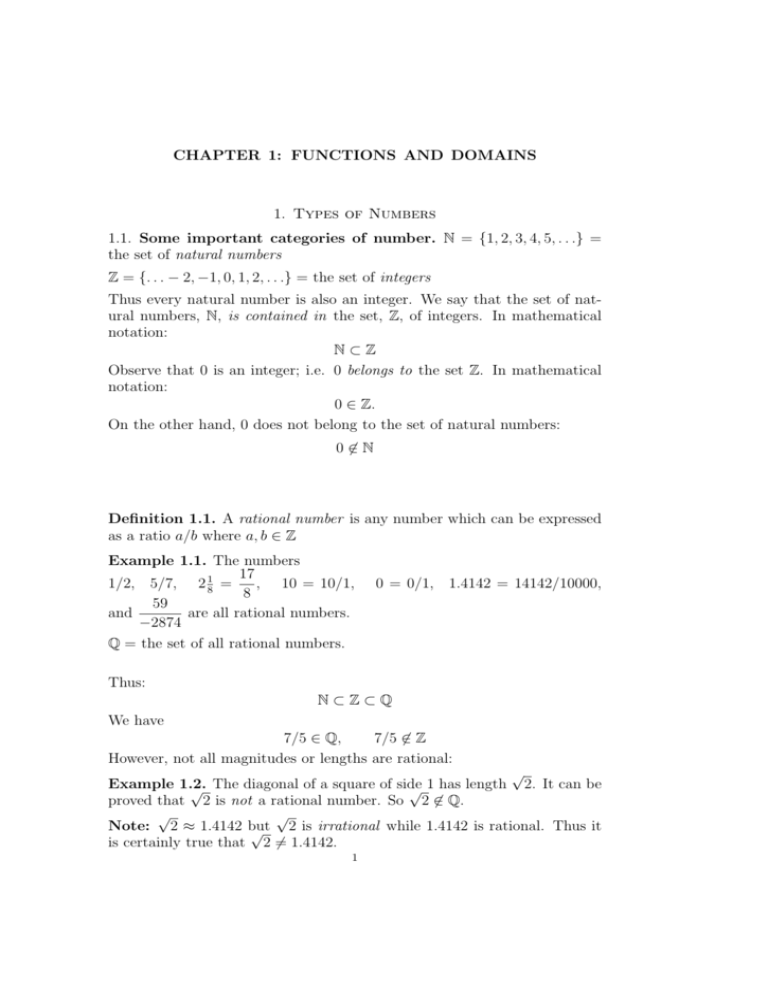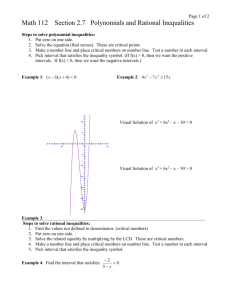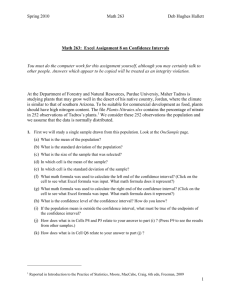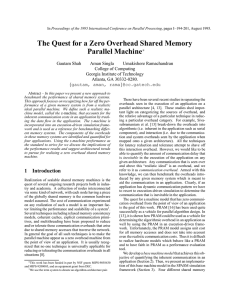CHAPTER 1: FUNCTIONS AND DOMAINS 1. Types of Numbers 1.1
advertisement

CHAPTER 1: FUNCTIONS AND DOMAINS
1. Types of Numbers
1.1. Some important categories of number. N = {1, 2, 3, 4, 5, . . .} =
the set of natural numbers
Z = {. . . − 2, −1, 0, 1, 2, . . .} = the set of integers
Thus every natural number is also an integer. We say that the set of natural numbers, N, is contained in the set, Z, of integers. In mathematical
notation:
N⊂Z
Observe that 0 is an integer; i.e. 0 belongs to the set Z. In mathematical
notation:
0 ∈ Z.
On the other hand, 0 does not belong to the set of natural numbers:
0 6∈ N
Definition 1.1. A rational number is any number which can be expressed
as a ratio a/b where a, b ∈ Z
Example 1.1. The numbers
17
, 10 = 10/1,
1/2, 5/7, 2 81 =
8
59
and
are all rational numbers.
−2874
Q = the set of all rational numbers.
0 = 0/1, 1.4142 = 14142/10000,
Thus:
N⊂Z⊂Q
We have
7/5 ∈ Q,
7/5 6∈ Z
However, not all magnitudes or lengths are rational:
√
Example 1.2.
The
diagonal
of
a
square
of
side
1
has
length
2. It can be
√
√
proved that 2 is not a rational number. So 2 6∈ Q.
√
√
Note: 2 ≈ 1.4142 but
2 is irrational while 1.4142 is rational. Thus it
√
is certainly true that 2 6= 1.4142.
1
2
First Science MATH1200 Calculus
Example 1.3. The numbers
shown to be irrational.
√
3,
√
5,
√
7,
√
8,
√
10,
√
3
3,
√
3
4, . . . can all be
1.2. The number π.
Definition 1.2.
π=
length of circumference of a circle
length of its diameter
(It can be shown that this number is the same for all circles; it is a constant.)
It can be proved that π 6∈ Q
(This was first established by J. H. Lambert in 1770.)
It is not too difficult to show the rational number 22/7 is a reasonably good
approximation to π. Of course, it could not possibly be equal to π, since π
is not rational. Similarly,
π ≈ 3.14159,
π 6= 3.14159
2. The Real Line, R
2.1. Depicting the set of real numbers.
Definition 2.1. A real number is any magnitude or length, negative or
positive, rational or irrational.
(This is only an informal definition, which is good enough for the purposes
of this course.)
The set of all real numbers is denoted R. Thus N ⊂ Z ⊂ Q ⊂ R.
√
√
2 ∈ R,
2 6∈ Q
The set (or collection) of all real numbers is visualized as a continuous
straight line, extending indefinitely both to the left and to the right, with
the integers at regular intervals along the line. This is called the real line.
ppppppppppppppppppppp
−3
√
R
−π
−2
−1
0
1
2
5/2
2
π
3
pppppppppppppppp
ppppp ppppppp
4
First Science MATH1200 Calculus
3
2.2. Order and Intervals on the Real Line.
Some Notation:
a<b
(read ‘a is less than b’) means that a is to the left of b on the real line.
Example 2.1.
2 < 3,
0 < 2174
−3 < 0
−5 < −3
−1 < 2
We also write
3 > 2,
2 > −1
(‘3 is greater than 2, etc )
a≤b
(‘a is less than or equal to b’) means that either a < b or a = b. Thus
2 ≤ 3,
3≤3
We can also write 3 ≥ 2
Note:
(1) a > 0 ⇐⇒ a is positive
(2) a < 0 ⇐⇒ a is negative
(3) a ≥ 0 ⇐⇒ a is nonnegative
The statement
2≤x≤3
means 2 ≤ x and x ≤ 3
5<a<7
means 5 < a and a < 7
Types of Intervals: Given a, b ∈ R with a < b, the set of all numbers x
satisfying
a<x<b
(i.e., the set {x ∈ R | a < x < b}) is denoted (a, b) and can be depicted as
follows
qqqqqqq
qqqqq qqqq
qqqqqqq
qqqqqqq
qqqqq qqqq
qqqqqqq
a
b
4
First Science MATH1200 Calculus
This is an open interval. It is a subset of the set R: in mathematical notation
(a, b) ⊂ R. a and b are called the endpoints of this interval. In the picture,
the circles about a and b tell us that the endpoints do not belong to the
interval.
The set {x ∈ R| a ≤ x ≤ b} is denoted [a, b]. It can be depicted in the
following way:
x
x
x
x
x
x
x
x
x
x
x
x
x
x
x
x
x
x
x
x
x
x
x
x
x
x
x
x
x
x
x
x
x
x
a
b
This is an example of a closed interval.
The solid circles about the a and b tell us that they are included in the
interval.
Caution: Do not confuse the point (a, b) in the plane with the interval
(a, b). The first is an element of the plane R2 , the latter a subset of R.
The interval {x ∈ R | a < x ≤ b} is denoted (a, b] and can be depicted as
follows:
pp p p p p p
ppppp ppppp
pp p p p pp
x
x
x
x
x
x
x
x
x
x
x
x
x
x
x
x
x
a
b
The endpoint a does not belong to this interval, while the endpoint b does.
Infinite Intervals
∞: ‘infinity’
This is just a symbol and not a number.
(a, ∞) = {x ∈ R | a < x} is depicted
p p p p p pp
ppppp ppppp
pp p p p p p
ttttttttttttttttttttttttttttt
ttttttttttttttttttttttt
a is its only endpoint.
∞ is never an endpoint.
[a, ∞):
tttttttttttttttttttttttttttttt
tttttttttttttttttttttt
x
x
x
x
x
x
x
x
x
x
x
x
x
x
x
x
x
x
a
(this includes the endpoint a.)
(−∞, a) = {x ∈ R | x < a}:
ttttttt
ttttttttttttttt
ttttttttttttttttttttttttt
ppppp
pppppp pppppp
pp p p p p p
a
We also have the infinite intervals (−∞, a]
and (−∞, ∞) = R.
First Science MATH1200 Calculus
5
2.3. Open and Closed Intervals.
Definition 2.2. An interval is said to be closed if it contains its endpoints.
Example 2.2. The intervals
[−3, 5],
(−∞, 58],
[−1, ∞),
(−∞, ∞)
are all closed.
Definition 2.3. An interval is said to be open if it excludes its endpoints.
Example 2.3.
(−1, 6),
(−∞, 14),
(15, ∞) (−∞, ∞)
are all open intervals.
Caution: The interval (2, 5] is neither open nor closed.
3. Functions
3.1. Examples and Definitions. When one quantity varies in a way that
depends on another quantity, we say that the first quantity is a function of
the second.
Example 3.1. Temperature at a given location is a function of time:
To give a more specific example, let us take as our location Cork City and
let us measure time in days. Then the temperature (at noon) in Cork city
varies from day to day. We could visualise this function as a long table part
of which would look like:
date
14/9 15/9 16/9 17/9
Temperature 13
12
16
11
in Cork City
Example 3.2. The area of a circle is a function of its radius.
Example 3.3. Mortgage repayments are a function of interest rates
Example 3.4. The pressure of a gas in a fixed container is a function of
its temperature.
Example 3.5. The gravitational pull of a planet is a function of its size
(mass)
The first quantity is often referred to as the dependent variable, the second
as the independent variable.
6
First Science MATH1200 Calculus
Definition 3.1. A function f from a set D to set S is any relation which
associates to each element of D an element of S.
We write
f :D→S
D is called the domain of the function.
S is called the codomain or target of the function.
Note: The domain and target of a function can be sets of any kind of
objects – not only sets of numbers.
Example 3.6. In the first example (Example 3.1) above, the domain, D,
is the set of dates and the target, S, the set of all possible temperatures
Example 3.7. In the second example, D = the set of all radii = (0, ∞)
and S = the set of all areas = (0, ∞)
3.2. The notation f (x). If x ∈ D, then the element of S associated to x
by f is written f (x) and is called the value of f at x.
Note: We can, of course, use any letter we want to denote a function – not
just the letter f . Sometimes another letter is more appropriate.
Example 3.8. Let T be the temperature function in Example 3.1.
Then T (15th of September) = 12.
Likewise, we can use any letter we choose – and not just x – to denote a
typical element of the domain.
Example 3.9. Let A : (0, ∞) → (0, ∞) be the ‘area-of-a-circle function’.
Then A(r) = πr2 for any r ∈ (0, ∞).
In our first example, there is no explicit formula for the temperature T on
a given date.
However, most of the functions of interest in mathematics are defined by
giving an explicit formula for f (x) in terms of x.
Example 3.10.
f : R → R,
f (x) = x2
So f (2) = 22 = 4
f (5) = 52 = 25
f (−3) = (−3)2 = 9
The domain is R and the codomain is R.
Example 3.11.
f : (0, ∞) → R,
f (x) =
1
x
The domain is (0, ∞) and the codomain is R.
Note: In these examples, x is the independent variable and f (x) is the
corresponding dependent variable. We often denote it by y and write
1
y = x2 ,
y=
x
First Science MATH1200 Calculus
7
and so on, instead of f (x) = x2 . . . etc.
3.3. Finding the domain of a function. If a function is defined by a
formula, the formula or expression must make sense when any element of
the domain is substituted in.
Example 3.12.
f : R → R,
f (x) =
1
x
is not a well-defined function since
f (0) =
1
0
does not make sense.
Often we talk of ‘the function y = f (x)’ without specifying the domain.
The domain is then understood to be the set of all numbers x for which the
expression makes sense.
Example 3.13. The function y = 1/x
Since it is possible to find 1/a (the reciprocal of a) for every number other
than zero, the domain consists of every number except 0; i.e. the domain is
the set (−∞, 0) ∪ (0, ∞).
(This set is a union of two intervals, but is not itself an interval.)
Example 3.14. The function y = x2
Since any number whatsoever can be squared, the domain consists of all
real numbers; i.e., the domain is R.
In each of the following examples, we express the domain of the function as
an interval or a union of intervals:
√
Example 3.15. y = x
Solution: The expression only make sense if x ≥ 0.
Domain = {x ∈ R | x ≥ 0} = [0, ∞).
√
Example 3.16. y = 1/ x
Solution: x = 0 is not in the domain. Neither, of course, is any negative
number.
Thus the domain is (0, ∞)
√
Example 3.17. y = 3x − 5
Solution: This make sense ⇐⇒ 3x − 5 ≥ 0
We need to solve the inequality 3x − 5 ≥ 0:
3x − 5 ≥ 0
3x ≥ 5
x ≥ 5/3
Domain = {x ∈ R | x ≥ 5/3} = [5/3, ∞)
8
First Science MATH1200 Calculus
Example 3.18.
y=√
1
3−x
Solution:
3−x > 0
3 > x
Domain = (−∞, 3).
Thus:
p
• To find the domain of g(x), solve the inequality g(x) ≥ 0.
1
• To find the domain of p
, solve g(x) > 0.
g(x)
1
• To find the domain of
, solve g(x) 6= 0.
g(x)
Caution: If you multiply both sides of an inequality by a negative number,
this changes the direction of the inequality.
Example:
3<5
Multiply both sides by −2:
−6 > −10
Example 3.19. Solve the inequality −3x < 18
Solution: Multiply both sides by −1/3:
18
x > − = −6
3
Solution set is (−6, ∞)



![The Average rate of change of a function over an interval [a,b]](http://s3.studylib.net/store/data/005847252_1-7192c992341161b16cb22365719c0b30-300x300.png)



